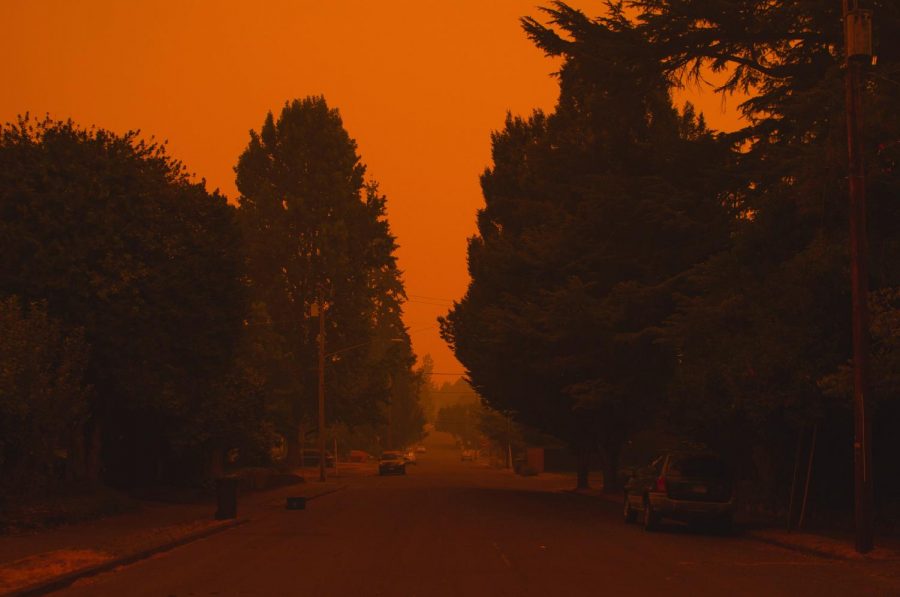OSU forest fire research, programs seek to help, educate on fire risk
September 14, 2020
With the recent wildfires across the West Coast, people have looked to ways to reduce the risk of fires in the future. OSU is at the forefront of forest management research and aims to educate about wildfires.
Oregon State University’s Forestry Department has been ranked as one of the top forestry programs in the world and the department has several professors that study forest management and fire science.
John Bailey, professor of forest engineering, resources and management, studies wildland fire ecology, prescribed fire and fuel management for fire risk. Bailey specifically has been studying stand structure and dynamics on fire hazards.
“Stand dynamics is predictable growth of the forest following disturbance—small disturbances or really big ones—in terms of composition and structure,” Bailey said via email. “The disturbance can be something like fire, or it can be harvesting or site preparation before planting.”
Most fire spread is linked to fine surface fuels, which include grass shrubs and litter close to the forest floor. Practices that focus on these surface fuels can contribute to limiting flame height and rate of spread, Bailey said via email.
Doing this can reduce the probability of fires turning into “crown fires,” fires that burn really hot and have embers flying downward that can result in more fires.
According to Bailey, another way to reduce fire spread and reduce the chance of fires turning into crown fires is to remove “ladder fuel” through mechanical pruning and mowing or prescribed fires. Ladder fuels are low branches and understory vegetation that allow the fires to reach higher heights.
“Trying these kinds of fuel treatments together over the hillside is the shape of the future – we know pretty much what to do, just not so much how much needs to be done and how to connect them,” Bailey said via email.
Meg Krawchuk, an associate professor in the department of forest ecosystems and society, focuses on studying fire ecology, landscape ecology and conservation science.
“I look at the drivers and outcomes of wildland fire,” Krawchuk said via email. “At heart, I’m a geographer: I call myself a pyrogeographer.”
The biggest challenge she sees facing conservation when talking about forest management and fire risk is weighing the costs and benefits. Fire is an important ecological process in ecosystems; some plants need fire in order to produce seeds like the lodgepole pine and knobcone pine. However, fire does burn outside of its historical range of variability and can result in the loss of homes and lives.
“It’s a balancing act of cost and benefit,” Krawchuk said via email. “Sometimes we see a win-win, such as the idea that with more low severity fire in dry forests we can reduce the likelihood of high severity fire. But more often it’s trade-offs.”
Not only does OSU have several faculty that study forest management and fire risk, but the College of Forestry has a state-funded program called the Forestry and Natural Resources Extension Fire Program, managed by Daniel Leavell, a fire specialist and associate professor of practice, and Carrie Berger, program manager.
The mission of the program is to “identify landscapes in highest need of a strategic focus of resources to reduce wildfire and landscape health risks at a statewide scale, assist with the implementation of projects on the ground in priority landscapes and provide fire science-based education and outreach throughout the process for all of Oregon,” according to the program’s website.
“It’s important to engage the public regularly to address both a better understanding of fire and the management opportunities that are available to landowners and homeowners,” Leavell said via email.
Leavell wrote that the program has worked to provide education on better management opportunities to reduce fire risk, and has had several workshops, webinars, podcasts and classes throughout the state over the past year.
“We need to address fire as a hazard that can be beneficial and detrimental within structures, surrounding structures and across the landscape,” Leavell said in an email.
With education, the program has assisted in cross-boundary landscape scale forest restoration, wildlife habitat, watershed health, fuel reduction and risk management projects.
“The program is gearing up to place four regional fire specialists within communities across the state, and hopefully two more this spring depending on budgets,” Berger said via email. “As such, our ability to provide more fire education and outreach events will grow.”
In the future, Berger hopes that the program will be able to increase fire knowledge and lessons, so that the next time a firestorm hits, Oregonians will be equipped to prevent catastrophic loss. She is also hopeful that the program will make a difference in helping to provide a healthy ecosystem that is able to bounce back from major disturbances.
“Forests are amazing!” Bailey said via email. “They provide wood and other non-timber products, clean water, wildlife habitat, recreational opportunities and just have value in and of themselves—but they are also fuel, and will burn sooner or later.”











































































































